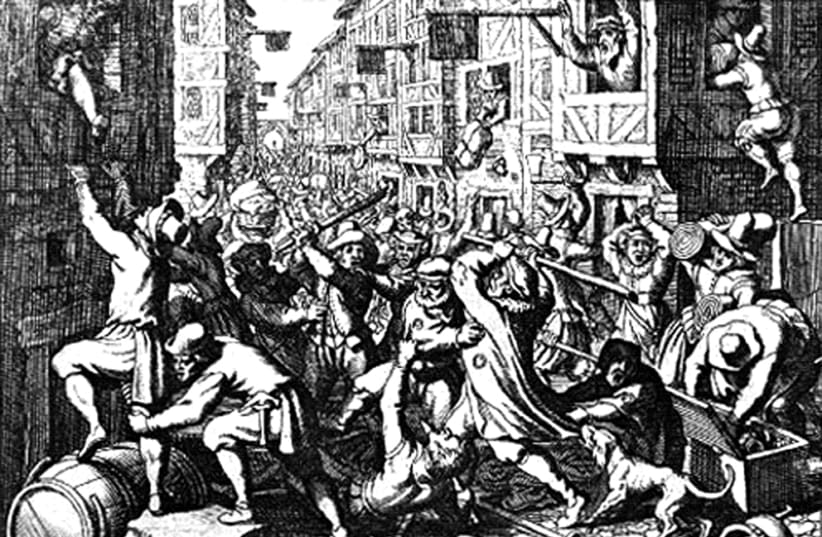Throughout Jewish history there have been mini-Purim holidays celebrated by communities seeking to honor a significant event. The Book of Esther describes the miraculous victory over Haman who sought to wipe out the Jewish community. In a twist of fate, he was hung on the gallows he erected to execute Mordechai, a leader in the Jewish community of Persia.
This theme has been taken up by Jewish communities in Israel and the Diaspora to mark their own Purim-style miracles. These days, Purim is celebrated with the recantation of special prayers and a festive meal, and sometimes a fast on the preceding day, similar to regular Purim.
The following is a brief list of notable Purim incidents in days of yore and one more recent historical tidbit.
1. Hebron Window Purim
Window Purim, or Purim Taka, took place during the Ottoman era in Hebron when a Pasha, or Turkish ruler, demanded a large sum of money or he would decimate the Jewish community of Hebron.The Jews of Hebron fasted and prayed, and dropped a special note they had written into a window of the building housing the ancient Cave of the Patriarchs.The next morning, a Jewish man found a bag on a window-seal with the exact amount of money the Pasha demanded. That night the Pasha dreamed that the Biblical Patriarchs Abraham, Isaac and Jacob came to him and warned him not to disturb the Jewish community. The next morning, when the Jewish community presented him with the ransom sum, he gave it back to them and rescinded his decree. The day was marked as Window Purim from then on.
2. Purim Vinz
In 1614, the head of the Frankfort, Germany bakers guild, Vincent Fettmilch, demanded less taxes and less Jews in the city. After he seized control of the town council, the Emperor called for order to be restored. In retaliation, a mob attacked the Judengasse, or Jewish ghetto. Two Jews and one Christian were killed when the Jewish residents took up arms to defend their homes and families. They were outnumbered by the mob. Their homes were looted and destroyed and the community was expelled.But the Fettmilch Rebellion was eventually put down by the authorities and its leader hung in the town square. The Jews were led back into the town the next day, during the month of Adar, the same month the regular Purim holiday takes place. A special scroll called Megilat Vinz was written and read every year to celebrate the occasion.
3. Purim Burghul
The Jews of Tripoli in today's nation of Libya celebrated Purim Burghul every year on the 29th of Tevet.A rebellion against Ali Pasha Qaramanli, led the Ottoman rulers to install Ali Burghul as the city's new ruler in 1793 and imposed heavy taxes upon the populace, particularly the Jewish community. Those accused of supporting the previous city's rulers were put to death including the son of the Rabbi Avraham Khalfon, the respected community leader.Rahamim Barda, a member of the Jewish community, eventually negotiated an agreement with the Qaramanli family and their supported and together they drove out the oppressive Burghul. Rabbi Khalfon composed a special prayer in commemoration of the ordeal.
4. Purim Saragossa
The Jews of Saragossa, the capital of medieval Spain's Aragon region, used to honor the king by dancing with their elaborately embroidered Torah cases during royal processions.In Sephardic communities, the Torah was kept in a rounded cylindrical box. Out of respect for the holy text, the Jewish community would carry the empty Torah cases to the parades.But a wicked adviser the the king named Marcus plotted to do away with the Jewish community by telling the king that this was a great insult. He advised the king that upon the next procession, he should check each Torah cases top see whether or not they were empty, and if so, then suffering would befall the Jews. But that night, the caretaker of one of the synagogues dreamed that a wise old man instructed him not to remove the Torah scrolls. Each caretaker of each of Saragossa's synagogues had the same dream. The next day when the king demanded the Torah cases to be opened, he saw that they were not in fact empty.The king then ordered Marcus to be executed. For generations, Spanish Jewry celebrated Purim Saragossa, even after the Spanish Inquisition.
5. The Nazis and Purim
Although not celebrated as a Purim holiday, an interesting entry to this list are the sardonic last words of Nazi propagandist Julius Streicher, which were "Purim Fest 1946."Streicher was one of the Nazi war criminals who were hung following the Nuremberg trials that determined the guilt of those who orchestrated the murder of six million Jewish civilians during the Holocaust. A day after Kristallnacht in 1938, Streicher referenced Purim as an example of how dangerous the Jews were stating, "the Jews butchered 75,000 Persians in one night... the same fate would have befallen the German people had the Jews succeeded in inciting a war against Germany... the Jews would have instituted a new Purim festival in Germany." Nazi leader Adolf Hitler banned Purim throughout Germany. In a 1944 speech Hitler noted that if the Nazis were defeated, the Jews could celebrate "a second Purim."
